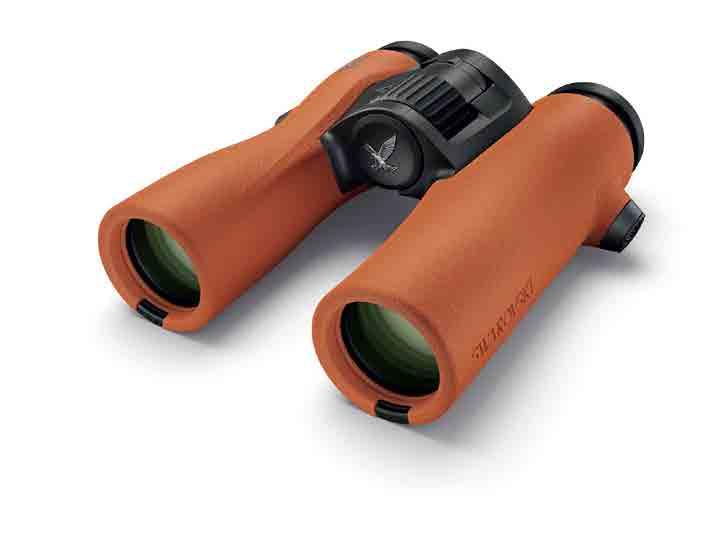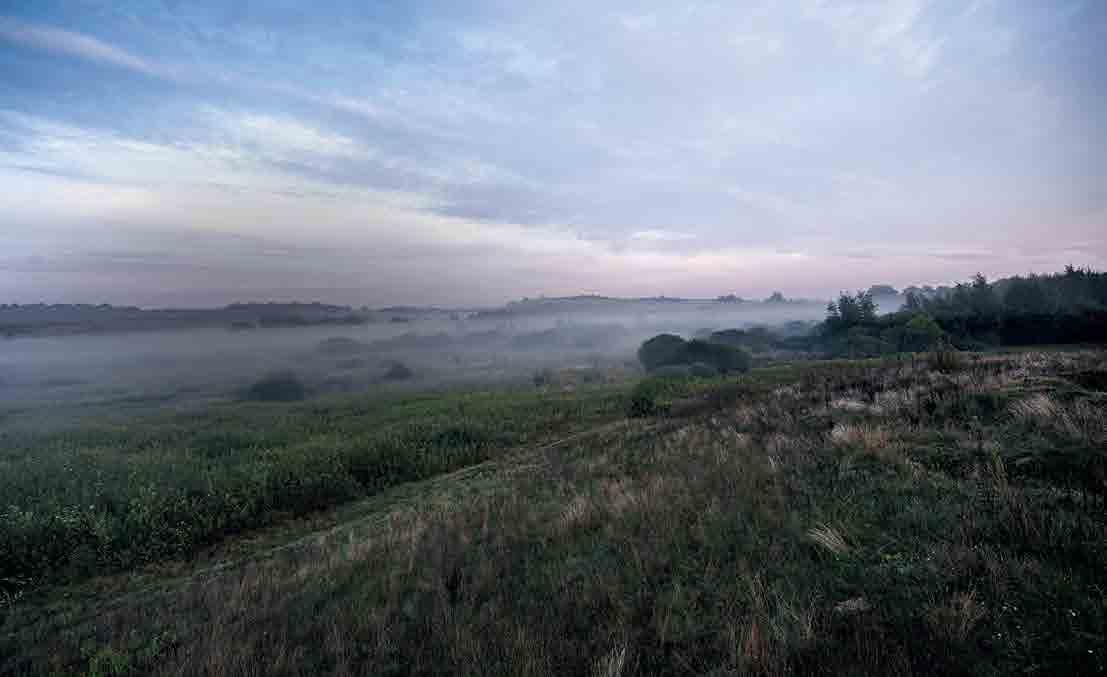
















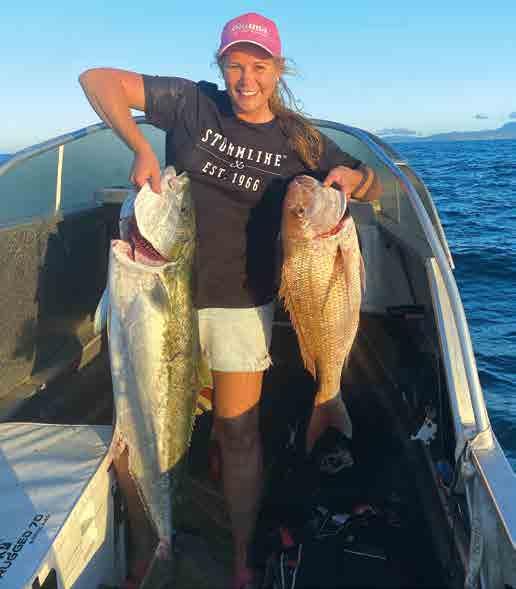

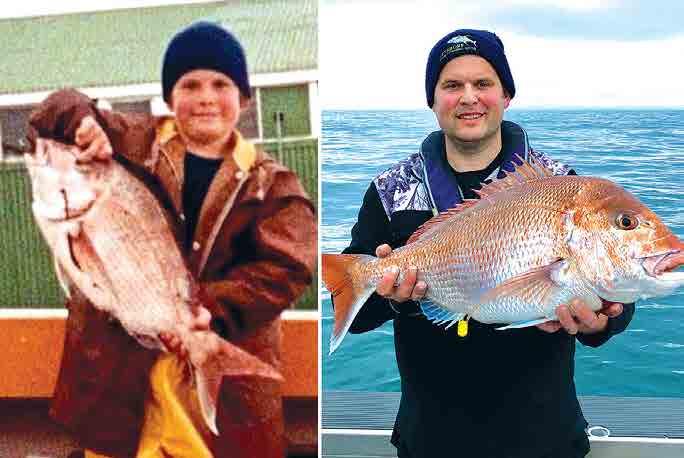



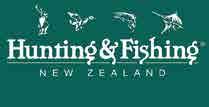



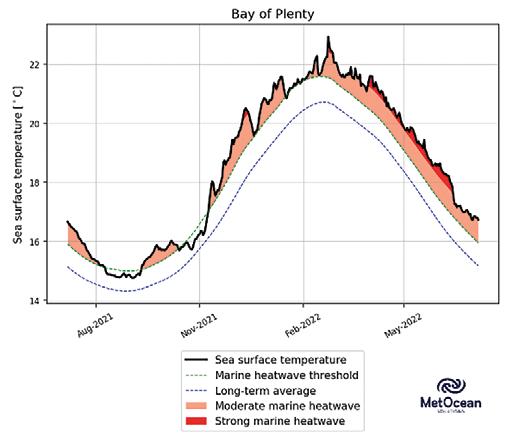
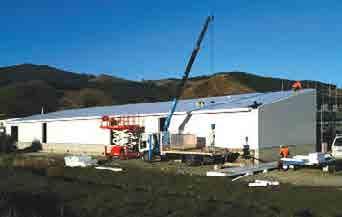





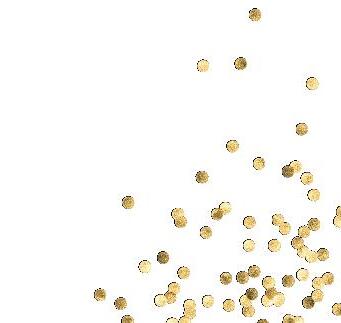










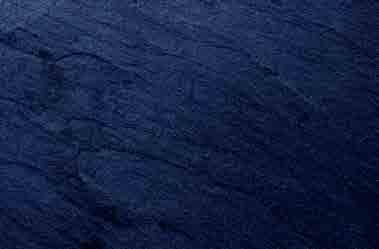












She had a nice sized lump, so I said, “Next time my rod goes o , pick it up

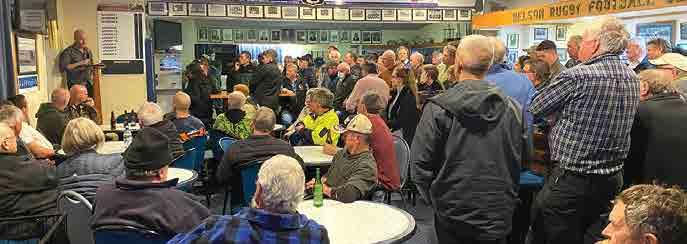
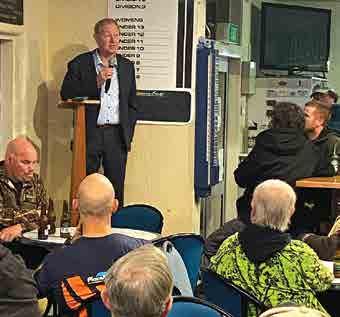
Last month, Fisheries New Zealand began public consultation on proposed amendments to Amateur Fishing Regulations in the Fiordland (Te Moana o Atawhenua) Marine Area (FMA). The Fiordland Marine Guardians are seeking changes to the amateur fishing rules within the FMA to align them with the philosophy of ‘fishing for a feed, not the freezer’. This consultation, which runs until September 30, marks a key milestone in the Guardians’ review of fisheries sustainability in the FMA.
The philosophy of ‘fishing for a feed, not the freezer’, guided the development of the original Fiordland recreational rules in 2005 with the establishment of the Fiordland Marine Management Act.
At that time, the Act, and the fisheries rules and regulations aligned with it, provided an innovative and future-focused means of ensuring Fiordland was cared for, for future generations.
Unfortunately, the current
regulations will not allow us to achieve healthy and sustainable recreational fisheries into the future.
The Fiordland Marine Guardians’ renewed focus on fisheries sustainability commenced in 2019 when several fishers and charter boat operators raised concerns about fish stocks within the FMA. Worry is centred on the health of key fish stocks within the fiords, inside the habitat lines, which have been solely an amateur/recreational fishery since 2005. As a group with extensive first-hand experience of the area, the Guardians shared their concerns.
Multiple species targeted by recreational fishers, including blue cod (rāwaru), groper (hāpuku), pāua, and scallops, are considerably depleted in the Internal Waters of the fiords. There is clear evidence of increasing fishing pressure over time and that trend is forecast to continue.
An unintended consequence of the fishing regulations introduced in 2005 has been a
concentration of fishing e ort in the entrances of many fiords, seaward of the habitat lines. There are clear signs that the current fishing pressure inside the fiords is unsustainable, and many key fish stocks require rebuilding.
This round of public consultation focuses solely on changes to amateur fishing rules and regulations. It marks a key milestone for our group following three years of engagement with Fiordland’s fishing charter operators and the fishing community. Ngāi Tahu ki Murihiku are represented on the Fiordland Marine Guardians and have helped shape the proposed amendments.
We are the first to admit that our proposal is not perfect. The problem we need to solve is complex and we all need to be part of delivering a workable solution for the good of this spectacular corner of the planet.
Management of recreational fisheries in New Zealand has been challenged by a lack of
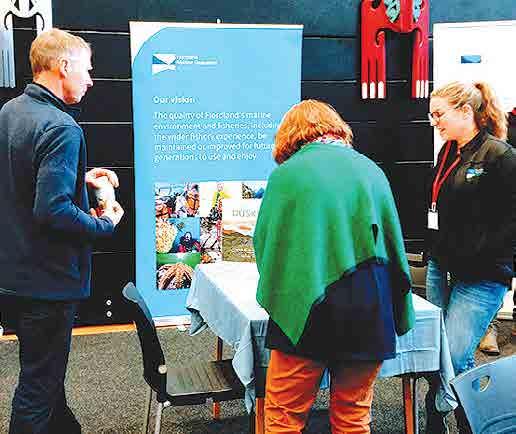
robust catch data. We are optimistic that a workable solution for Fiordland is within reach. Fish Mainland is a not-for-profit organisation with the aim of providing a unified voice for the marine recreational fishing community in the South Island and Stewart Island and have developed a self-reporting app in conjunction with Fisheries New Zealand. Crucially, Fiordland’s fishing community has expressed a strong willingness to use it. We will continue to
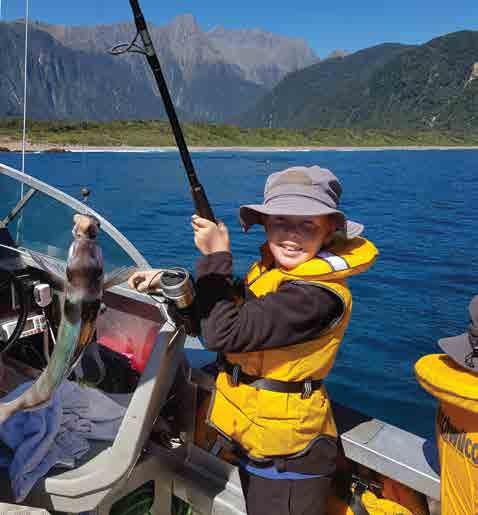
advocate for these initiatives and develop a more holistic way of managing the entire fishery in the years ahead.
Before making a submission on the proposed amendments we encourage everyone to learn about the problem we need to solve and the details of our proposal.
Your input will help us strengthen the proposal and make any changes to the amateur fishing rules for the FMA more likely to succeed.
You can read the full
proposal and download a submission form at mpi.govt. nz/consultations/reviewof-recreational-fishingmeasures-fiordland-marinearea or scanning this QR code.

Let’s look a er this incredible place so future generations can enjoy it too
We encourage you to fish for a feed, not for the freezer.
As a group, we’re responsible for managing and caring for Fiordland’s precious marine environment. Before you set o , make sure you know the “where, what and how” about fishing in Fiordland. Clean your vessel and gear so you don’t take any unwanted visitors with you.
Connect with us at FMG.org.nz
Mya-Rose Craig
Penguin Random House
RRP $40
Reviewed by Daryl Crimp
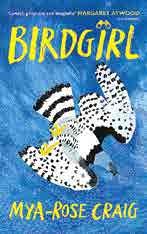
James Patterson: The Stories of My Life
James Patterson
Penguin Random House
Reviewed by Daryl Crimp
RRP $40

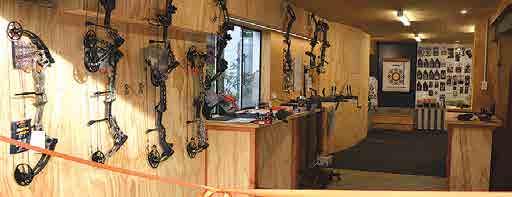
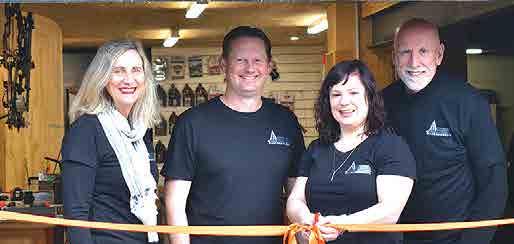







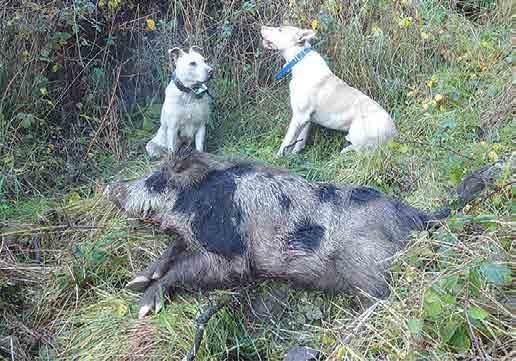

No.8 bow strings epitomise New Zealanders can-do approach to life.
Designed by Advanced Archery’s Carol and Kevin Watson for our rugged conditions and made right here in New Zealand. We’ve refined the latest string building techniques, equipment, and materials we use through constant field testing to get the string quality we’re excited about.
Go Kiwi with all black or choose from thousands of colour combinations with clear serving to customise it your way.
Pre-stretched for zero peep rotation, with speed buttons installed and a bow tune, we’ll send your bow back to you shooting as good as new, maybe even better!

For the Mustang, hunter, fisher, tractor, car enthusiast, man-cave and more, there is a sign here on display at our show room to suit everyone. New stock arriving daily now for Christmas so visit us at Ellis Street Auto, Ph 03 542 4035 104a Ellis Street, Brightwater, Nelson From only $30 these signs make amazing gifts




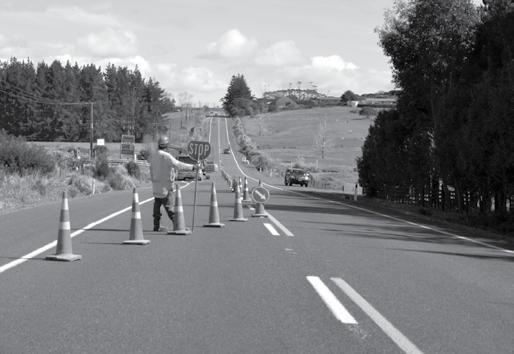


Slow decline is hard to notice. Each generation can have quite di erent views on what constitutes natural or normal fishing. Those who have fished for several decades can recount how fishing has changed in their lifetimes.
For example, in the Kaikoura region, there are longstanding locals who can recount when pāua were so abundant they were readily harvested in shallow, wading depths. Most of us never witnessed such abundance until the 2016 earthquake uplifted pāua habitat from several metres’ depth and the stock rebuilt while the fishery remained closed.
This all changed when the pāua fishery re-opened 1 December to 28 February.
According to Professor David Schiel, the University of Canterbury research shows that, with up to 1,000 people a day harvesting pāua, 75 percent of the pāua biomass over the 125mm Minimum Legal Size (MLS) was removed from the shallow, wadable depths.
This level of removal was foreseen, causing several to sound warnings and propose measures that would have significantly
constrained the anticipated recreational harvest.
However, the government opted to forego acting on such warnings and related measures. It appears the government placed little value on preserving the future of the abundant fishery in shallow, wadable depths.
If this attitude persists, then we may never again witness such abundance in the pāua fishery. At best, the fishery could revert to abundance like what was ‘normal’ pre-earthquake. At worst, the fishery could be at risk, requiring several years to recover.
This would be a travesty of fisheries management. Why?
First, the fishery shows better than most that commercial fishers are not the scourge of the earth and responsible for all that might go wrong in fisheries management. In fact, the commercial pāua fishers continue to show exemplary voluntary e orts in halving their total allowable catch and harvesting pāua above the 125mm MLS.
Second, recreational fishers were lawfully allowed to pillage the easy pickings in shallow, wadable depths. However, such pillaging compromised important, vulnerable breeding populations that support recruitment across the wider fishery.
Third, the government’s information on recreational fishing in the Kaikoura region was highly inaccurate. This explains why the recreational allowance was set at 5 tonnes (in PAU3A) yet the historical harvest was likely much higher; the estimated harvest during the 3-month opening exceeded the 5-tonne allowance more than 8-fold (42 tonnes).
Fourth, despite the warnings, the government’s actions comprised familiar measures (season length and daily bag and size limits) that alone could not stem the tide of excessive recreational e ort. This situation requires a complete re-think of how to fix the fishery to avoid further decline of the fishery, especially in shallow, wadable depths. And most agree that the long-term fix must include the input of all concerned and significantly
better information on recreational catch and e ort so that the fishery can be closed once the recreational harvest reaches the allowance.
For this purpose, Fish Mainland is expanding its MPI-funded recreational fisher self-reporting system that initially was developed for the South Island blue cod fishery. The system, with its phone app appropriately named Mainland Catch, is being expanded as a key component to fixing this fishery and other shared fisheries that are important to recreational fishers.
For now, the Government is proceeding with consultation on changes to near-term management measures that could allow for the next pāua opening. However, the current regulatory timeframe constrains the near-term options.
We hope the measures put in place for the next opening will su ciently constrain recreational harvest to preserve a new normal for the fishery, abundance in shallow, wadable depths.
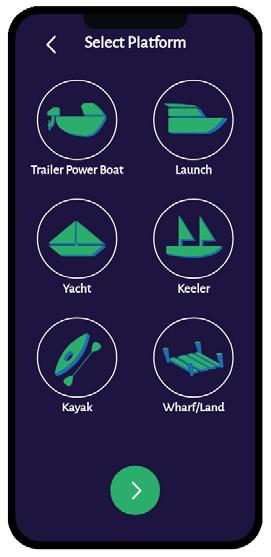




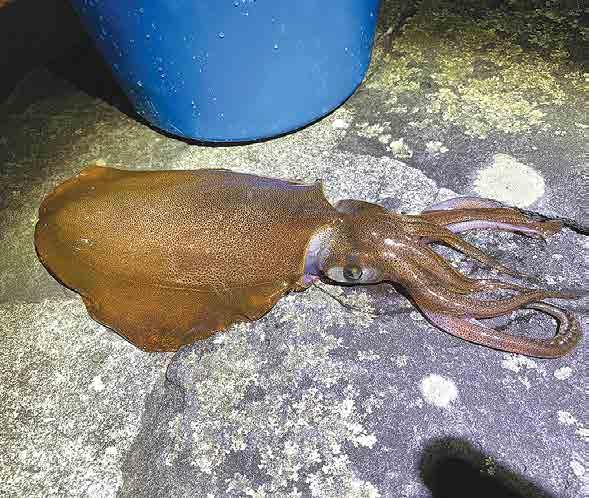

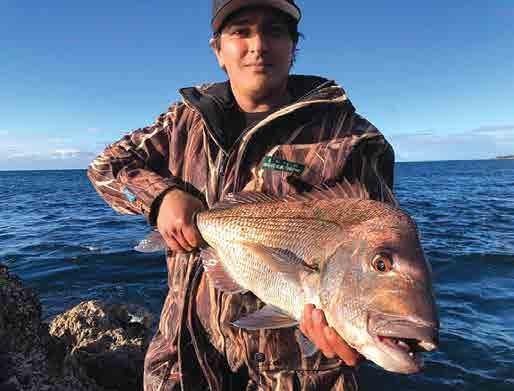


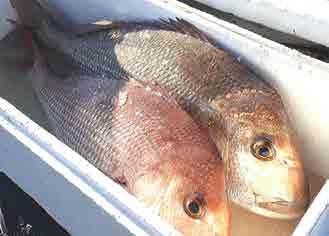
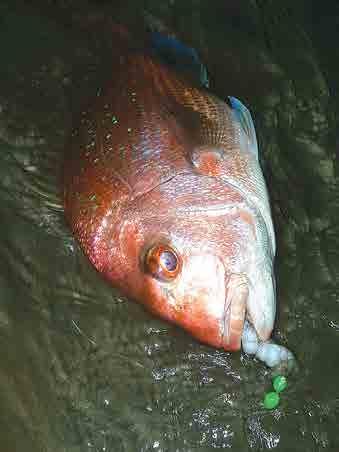
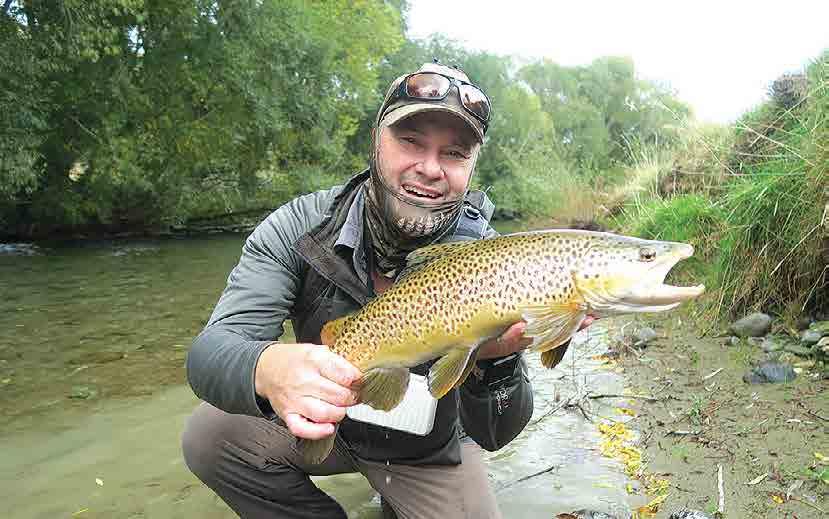





Located around 800kms east of New Zealand, with around 360kms of coastline, the Chatham Islands is a place of extremes—the weather is harsh, the seas fierce, freight logistics di cult and there are great white sharks in the water. Despite these challenges, around 30% of New Zealand’s wild harvest pāua comes from the Chatham Islands. This job requires a good level of fitness and strength but more than anything—motivation. Getting up early on a winters morning to check conditions before pulling on the wetsuit isn’t for everyone. I sat down with Nick Cameron to see what a day in his life as a pāua diver looks like.
Pāua diving is dependent on the weather for good conditions.
“Good visibility is key. It gives us a good chance to see what’s out there and what’s going around you, and gives everything a good chance to see us as well and identify what we are”.
Wind, swell, visibility, and tides are important as well as the current harvest management plan: the Chatham and Pitt Islands are split into 57 di erent areas each with quota limits and size restrictions.
The 57 areas can be as small as a stretch of reef with catch capped at only two tons each year and once an area reaches that quota, it is closed until the following season. This can be checked using any of five industry software, Nick’s preference is Pāua4.
Divers harvest product specifically for the current order and sizes may change for live, whole Individually Quick Frozen (IQF) or canned product. A skipper on the boat watches for the location of the divers, collects the harvest, remeasures and grades as they go. The minimum harvest sizes for pāua change with each area, meaning extra care is taken when measuring and grading.
The harvesting itself is not di cult if you are experienced. The best of the pāua beds are in relatively shallow water,
normal working depth ranges from 2 to 5 metres, but can be a fair distance o shore in some places.
Once an area of adult pāua is found, it’s a case of breathing up, relaxing and heading down.
The first action is to judge sizes by eye, experience helps, before using a blunt, round edged stainless steel “ab iron” to carefully pry them o the reef. A good diver will only remove pāua at or larger than the minimum harvest size and the “ab iron” will have a measuring device to double check. Anything too small goes back on the reef. When the catch bag is full, the diver calls over the support vessel and swaps the full bag for an empty one. When the dive is complete and the pāua are graded, Nick contacts one of the factories on the island and delivers his product for further processing or to be packed and flown live o the island.
Traditionally pāua diving is done by freediving, the record is thought to be 60 in one breath. The best technique for this is many shorter breath dives throughout the day rather than fewer long ones.
Although, the Chatham Islands commercial pāua divers are allowed to use scuba gear to harvest their catch, due to the risk from great white sharks. The ability to stay on the bottom longer minimises their time in the midwater where most
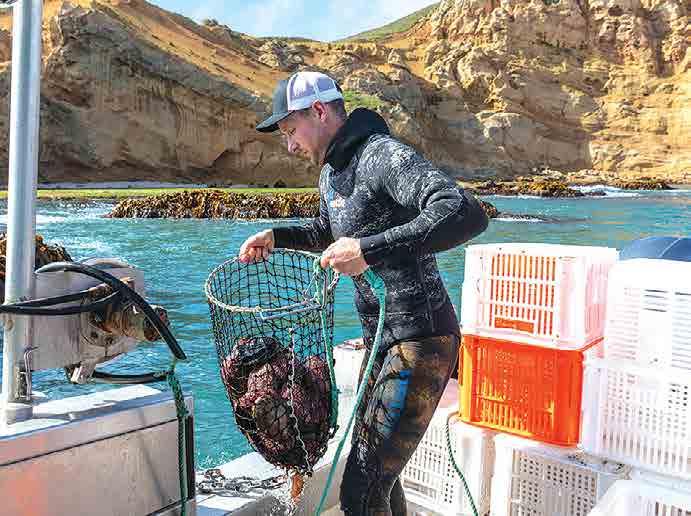
shark encounters occur. Face to face encounters with Nick in the water number 14, but that number is over 20 with his crew.
“You never forget your shark encounters; you talk to other divers and certainly everyone remembers each of theirs.”
It’s not all work and no play though. After 15 seasons, Nick has many stories to share. Some of his most memorable dives include interactions with seals, dolphins and even whales.
“Any of those experiences we don’t just charge on ahead to go and do a day’s work. We try and appreciate them and take it for what it is.”
Speaking to Nick about the pāua industry was fascinating. They are a long way from the mainland, which means the research and science behind quota management has sometimes

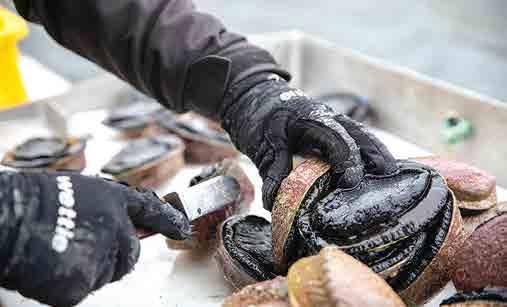
been slow. Nick says the industry is moving in the right direction with the fisheries management plan they have in place. His goal over the last fifteen seasons, and moving forward, is to leave behind a resource and food source that future generations can appreciate. Pāua diving has been a bit of a hard sell for the younger guys in the last few years. The industry has been a bit depressed and of course the shark risk puts a few people o but, with the industry moving in the right direction, Nick hopes some younger divers will see it as a good career option.
Having spent a few days out on the water with Nick, I have a great appreciation for the work the guys do out here. If diving in some of the most extreme conditions in New Zealand sounds like fun, perhaps put the Chatham Islands on your radar.
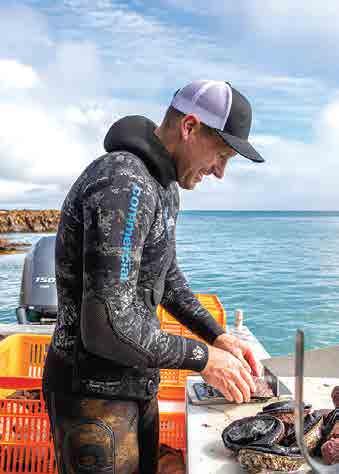




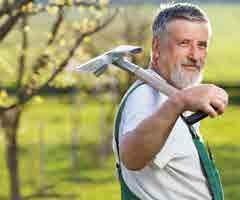



















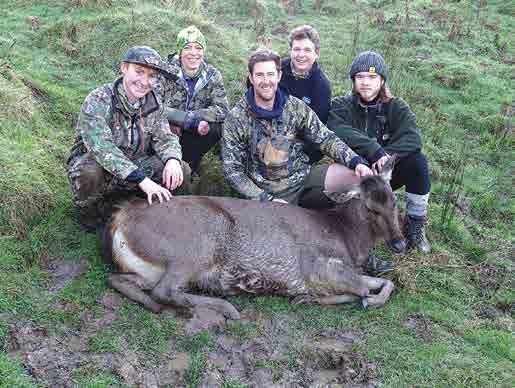
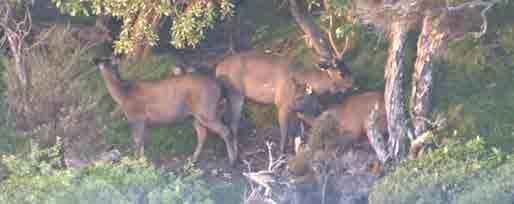






I still was not happy so headed along to Hunting & Fishing for advice. I discovered there was a Swarovski ballistic app which is amazing.
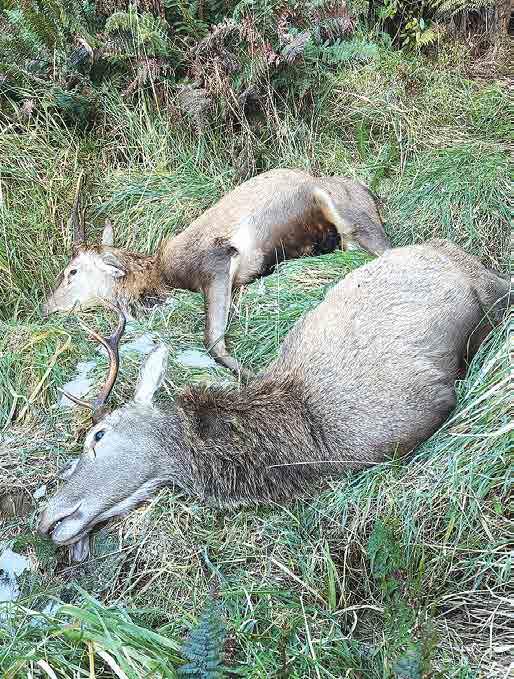
Want to escape the everyday bombardment of information and escape outdoors? Still want to be contactable if it’s important? Pick up an
inReach Satellite device from TrackMe NZ with a NEW Dedicated SMS number. TrackMe NZ are now able to o er dedicated SMS numbers to inReach

devices to enable better connection from text capable devices.
“This development has been 3 years in the making and allows our clients the freedom to connect with anyone else on the globe via their inReach device. It is the missing piece of the puzzle that will allow our customers to fully connect with other users of GARMIN inReach and ZOLEO devices around the world. For our adventurers it sets a new standard in the world of communication.” - David Tait
– National Sales Manager, TrackMe NZ Dedicated SMS numbers allocated to TrackMe
NZ inReach devices are maintained on the TrackMe NZ Portal and deliver to all mobile networks throughout the globe.
A TrackMe NZ customer can request a number be assigned to their inReach device and,
• This will be a direct
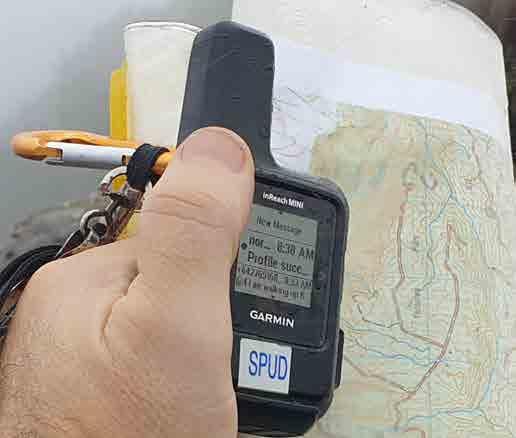
number for people to text to the inReach device from a cell phone, satellite phone, GARMIN connected inReach, ZOLEO, or SPOT-X.
• It will register with any device that the inReach communicates with as a valid SMS capable number.
Customers can apply for a number on the connection form when first connecting to TrackMe NZ or, for existing customers, by email request to: support@trackme.life

The Fishing Paper & Hunting News.
So here I am at the time of writing, a week into owning a 10-week-old black labrador bitch, who is just starting to answer to the name of Whoopi and cost me more than a few cars I’ve owned.
Earthwalk’s new Bu alo Boots. There really isn’t another boot to match them.
The bu alo leather is 175% more crack resistant than normal leather. Which means they will last longer than most boots.
Imagine being 8 hours in
the bush and your outsole comes o . You don’t want that. That’s why Earthwalk stitches the leather upper directly to the outsole to ensure it never falls o .
The boots have a wide toe box for improved downhill comfort. A new ball-bearing speed lacing





system distributes pressure evenly. And we opted to use flaps for the lower hardware unlike traditional tramping and hunting boots - where the lower D-rings tend to dig into the leather hurting your foot and cutting through the upper over time. Our boots won’t do that.
The boots now come with a new high-strength forestrygrade steel shank. Safety models feature a new wide steel cap and a new Kevlar penetration-resistant sole. Find them at: earthwalk.co.nz or phone 0800 16 00 24





The recreational scallop season opens on 1 September and while some popular areas are closed so they can rebuild, there are still areas where gatherers can try catching this seafood delicacy.
“Catch only enough for a feed. That’s our message. If everyone does this, our fisheries will be sustainable for generations to come,” says Emma Taylor, Director Fisheries Management, Fisheries New Zealand.
In April, the Oceans and Fisheries Minister David Parker closed the Northland fishery, and most parts of the Hauraki Gulf and Coromandel fishery to both recreational and commercial scallop fishing to allow beds to rebuild. There are two areas around Hauturu/ Little Barrier Island and near the Colville Channel that are still open.
The closure in Coromandel also a ects parts of the Western Bay of Plenty.
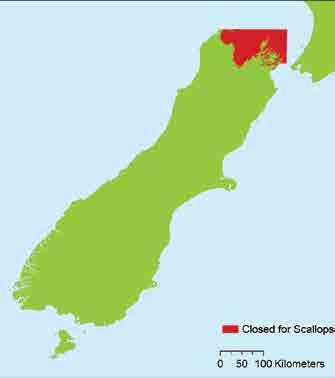
Mōtītī Island is closed to scallop fishing and there are restrictions in place that stretch as far as Maketu. MPI has signage in place in the Bay of Plenty to highlight these restrictions
In addition, the scallop fishery in the Nelson –Marlborough South Island area has been closed for several years so it can recover and rebuild stocks, and these e orts are ongoing.
“There are still areas

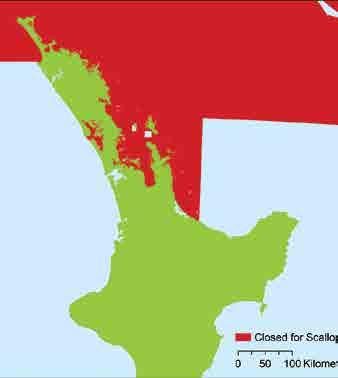


throughout New Zealand where you can get scallops and one of the best things you can do is download the free Fishing Rules app and check the rules and regulations for the area you intend to fish.
This app will show you areas that are closed and those that are not. By checking this information on your app, you’ll also learn about the daily catch limit too, so you’ll have information about the rules at your fingertips – even if your phone is o ine,” Emma Taylor.
Meanwhile, with significant closures of scallop fisheries for rebuilding, you can expect MPI Fishery O cers to be visible
so to ensure the closures are being respected.
“Taking scallops from areas that are closed could result in a significant fine. We’d encourage fishers to respect the rules – do your part in helping the areas that are closed to recover so they can be fished again in the future when it’s at a sustainable level,” says MPI National Manager of Fisheries Compliance, Niamh Murphy. MPI encourages people to report suspected illegal activity through the Ministry’s 0800 4 POACHER number (0800 47 62 24).



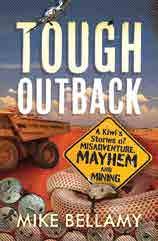






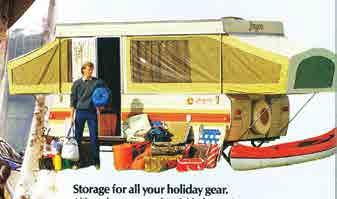

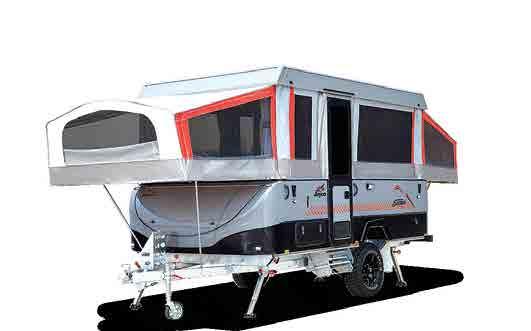
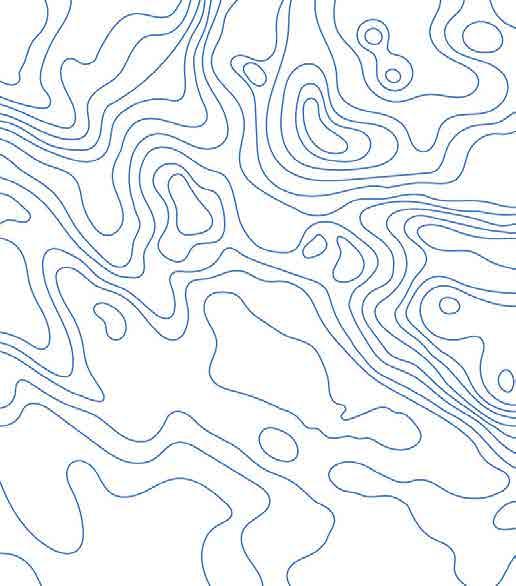









Previous articles have noted the consequences to fishers and to fish stocks of the closure of fishing grounds. The displacement e ect forces e ort into smaller spaces, leading to localised spatial depletion. The challenge is to manage fishing; to paraphrase the Fisheries Act—the goal is to enable utilisation whilst ensuring sustainability.
One government agency is responsible for fisheries management in accordance with the act, and it seems to have thrown in the towel. Managing fishing has obviously proven too di cult—other than in the commercial sector where all manner of constraints, surveillance and penalties apply. Hence, the agency’s fall-back position is to close areas to fishing—the mismanagement approach.
Currently, there are two formal consultation processes underway. The first relates to a proposal to ‘temporarily’ close 300 square kilometres of Taranaki waters to all extractive use other than for finfish, between the Rawa
Stream in the south and Herekawe Stream, near New Plymouth’s Back Beach, in the north, and out to two nautical miles. The second seeks feedback on the renewal of a two year temporary closure at Waimārama in Hawkes Bay. Several weeks earlier, a separate proposal to close a large area around Great Barrier Island was under consideration and that was followed up with yet another proposed closure in the vicinity of Great Mercury Island. It is worth noting that those two northern proposals are completely unrelated to the imminent Hauraki Gulf spatial management plan (closures to fishing) previewed earlier this year.
The current closure proposals are being made under s186A of the Fisheries Act 1996, which provides that the Minister of Fisheries may temporarily close an area in respect of any species of fish, aquatic life or seaweed. Before doing so, the Minister must be satisfied that closing

the area will recognise and provide for the use and management practices of tangata whenua in the exercise of non-commercial fishing rights by: improving the availability or size (or both) of a species of fish, aquatic life or seaweed; or • recognising a customary fishing practice in that area.
Taranaki Iwi consider that the temporary closure will provide time for pāua and other taonga species that are being overfished, to regenerate to ‘levels of sustainability which would ensure their continued survival for the benefit of future generations’.
Several aspects of their proposal deserve scrutiny. The assertion that species are being overfished—there is no stock monitoring or research information o ered in support of that claim. However, something is clearly wrong and Iwi requesting the closure and those concerned about being locked out should be asking why overfishing was allowed to occur. The
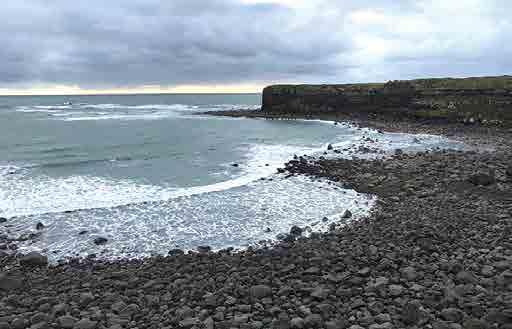
second aspect is the Iwi expectation that a two year temporary closure will provide the opportunity for stocks to regenerate. Clearly that is not the case. Similar closures elsewhere have failed in that regard, despite repeated renewals. Case in point, the Waimārama renewal also being consulted at the same time. Ngāi Hapū o Waimārama have requested the Minister for Oceans and Fisheries impose a further temporary closure under s186A to prohibit the take of pāua for a two-year period. Again there is no stock monitoring information in support of that proposal but, on the basis of the request itself, the applicants have no doubt that the first two year closure did not achieve what was expected. Neither have
multiple two year closures on the Kaikoura coast and Maunganui Bay in Northland. The closures are little more than an admission of defeat—a confirmation that we have an agency apparently incapable of managing fishing. Back to Taranaki. The size of the proposed closure is extreme in the context of the problems that allegedly initiated the request to the Minister. The legal prohibition was requested by the hapū of Taranaki Iwi following alarm over summer that the region’s pāua beds were being stripped bare by hundreds of visitors, many but not all from outside the area. But interestingly, and predictably, the hapū do have a plan to manage fishing given that no-one has been doing it properly to date.
Recreational management plan desperately needed Active steps are needed to measure and manage recreational catch—the key source of unmanaged fishing pressure in the locality (there has never been a commercial pāua industry in Taranaki). Iwi have announced that possible future measures to protect the kai moana could include increasing the size for takeable shellfish, lowering the daily bag limits, and making it illegal to take pāua o rocks—so it could only be harvested by diving— and having short closures to protect the shellfish beds during the very low tides that had attracted crowds of outof-town harvesters over the summer.
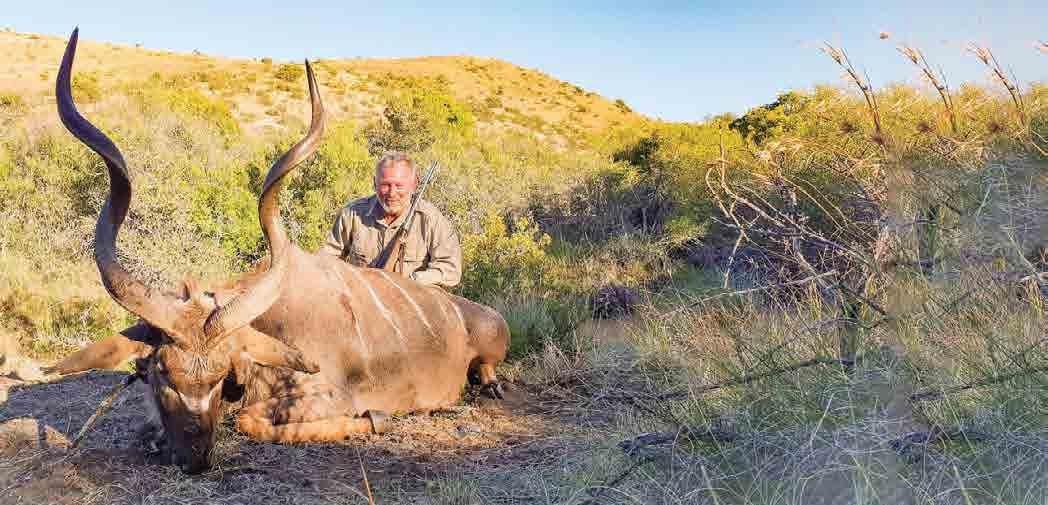

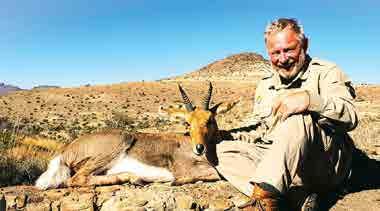
Hapū should kick that management plan o immediately. It’s pointless waiting two years to get started because, on top of that, it will take twelve months or more to implement, so three years down the track nothing positive will have been achieved, despite good intentions.
The overreach of the proposed closure is also a guarantee of strong objections from recreational and commercial harvesters, whereas well-constructed regulatory proposals would surely have community and inter-sectorial support.
Compelling reasons why everyone with an interest in going fishing and diving for food and recreation should oppose these ‘temporary closures’ in favour of managing fishing in a timely and practical manner.
Lobster boys vote management over displacement
The rock lobster industry will have no choice but to strongly object to the Taranaki proposal—the two nautical mile closure would put an end to all potting for a stock that is demonstrably well monitored and sustainably managed. Don’t assume that the resident lobster boats can just move along the coast and keep fishing—hapū to the north have already signalled their intentions to extend the currently proposed closures, because they too understand the consequences of displacement. However, and for the record, the lobster industry would support measures to adequately manage fishing on the Taranaki coastline (and elsewhere).
Existence of a s186A closure
and expectations that it will be renewed time and again without due scrutiny is likely to detract from, rather than incentivise, the development of more appropriate and e ective management responses. Closures will remove legitimate users from productive fishing grounds, result in displacement of e ort, and exacerbate localised depletion in other areas. Closures also facilitate poaching, once legitimate users move away.
Playing into hands of poachers
There are numerous media reports of poaching along the Taranaki coastline. In one day in 2005, ten fisheries o cers nabbed o enders as they left various beaches—from Cape Egmont to Opunake—and confiscated 1300 illegal pāua. Additionally, 15 infringement notices were issued in one

night and eight prosecutions were set to follow. The alleged o enders were all locals!
Media reported a Fishery O cer saying that a “disgusting” amount of pāua was confiscated from several o enders, many times more than recreational fishing limit. “We took hundreds o some people.”
There are nearly two decades of similar media reports since. If o enders are not deterred by bag limits, size limits and/or risk of prosecution, they are hardly likely to be deterred by closures.
Temporary closures will exacerbate competition and conflict between users and likely fuel the ongoing cascading series of ad hoc closures in the North Island, with the remaining fishing e ort increasingly concentrated in just a few areas. This is clearly not a sustainable approach to fisheries management and it undermines customary fishing rights by hindering the ability of other nearby hapū to exercise their customary fishing rights in their own rohe moana.
The last word goes to the Taranaki recreational fishing clubs. Their spokesperson, when acknowledging Iwi concerns, wisely noted that the club would like rock lobsters to be managed separately, including bag limit sizes, spatial requirements and enforcement, rather than included in the proposed ban,

Hospice nurses and volunteers working together can help patients remain in their own homes.
Nelson Tasman Hospice is seeking “Hunting Shooting Fishing” volunteers to join our patient support volunteer team .
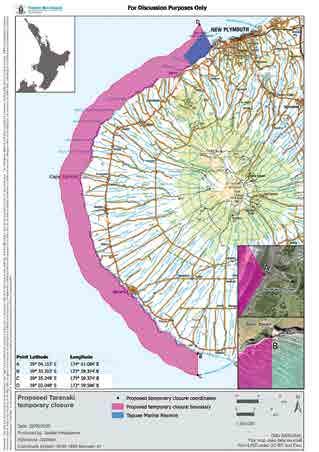
which would see all diving for lobsters and most potting from boats prohibited.
“The anecdotal evidence is that cray populations overall along the coast are the best they have been for decades, although we are aware of spatial conflict and localised depletion seasonally. Full closure of such a large area would displace fishing to areas north and south of the closed area. If overall management is not considered, we will see the
same issues moved along the coastline.”
True that. Now that the Taranaki hapū have forced the issue it would be both timely and appropriate for the agency charged with providing for utilisation whilst ensuring sustainability to get started on the process of managing fishing. They could get some useful guidance from Taranaki locals who have been highlighting the depletion of shellfish on inshore grounds for decades.

Usually 2-4 hours during


